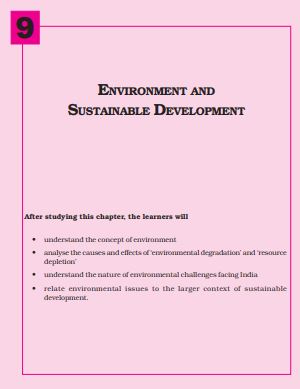‘NCERT Solutions for Class 11 Economics Chapter 9 Environment and Sustainable Development NCERT Textbook PDF‘ PDF Quick download link is given at the bottom of this article. You can see the PDF demo, size of the PDF, page numbers, and direct download Free PDF of ‘Ncert Class 11 Economics Chapter 9 Exercise Solution’ using the download button.
Environment and Sustainable Development Book PDF Free Download

Chapter 9: Environment and Sustainable Development
In the earlier chapters, we have discussed the main economic issues faced by the Indian economy.
The economic development that we have achieved so far has come at a very heavy price at the cost of environmental quality.
As we step into an era of globalization that promises higher economic growth, we have to bear in mind the adverse consequences of the past development path on our environment and consciously choose a path of sustainable development.
To understand the unsustainable path of development that we have taken and the challenges of sustainable development, we have to first understand the significance and contribution of the environment to economic development.
With this in mind, this chapter is divided into three sections. The first part deals with the functions and role of the environment. The second section discusses the state of India’s environment and the third section deals with steps and strategies to achieve sustainable development.
9.2 Environment: Definition And Functions
The environment is defined as the total planetary inheritance and the totality of all resources. It includes all the biotic and abiotic factors that influence each other.
While all living elements birds, animals and plants, forests, fisheries, etc. are biotic elements, abiotic elements include air, water, land etc.
Rocks and sunlight are all examples of abiotic elements of the environment. A study of the environment then calls for a study of the interrelationship between these biotic and abiotic components of the environment.
Functions of the Environment: The environment performs four vital functions (i) it supplies resources: resources here include both renewable and non-renewable resources. Renewable resources are those which can be used without the possibility of the resource becoming depleted or exhausted.
That is, a continuous supply of the resource remains available. Examples of renewable resources are the trees in the forests and the fishes in the ocean.
Non-renewable resources, on the other hand, are those which get exhausted with extraction and use, for example, fossil fuel (ii) it assimilates waste (iii) it sustains life by providing genetic and biodiversity, and (iv) also provides aesthetic services like scenery etc.
The environment is able to perform these functions without any interruption as long as the demand on these functions is within its carrying capacity.
This implies that the resource extraction is not above the rate of regeneration of the resource and the wastes generated are within the assimilating capacity of the environment.
When this is not so, the environment fails to perform its third and vital function of life sustenance and this results in an environmental crisis.
This is the situation today all over the world. The rising population of the developing countries and the affluent consumption and production standards of the developed world have placed a huge stress on the environment in terms of its first two functions.
Many resources have become extinct and the wastes generated are beyond the absorptive capacity of the environment. Absorptive capacity means the ability of the environment to absorb degradation. The result — we are today at the threshold of environmental crisis.
The past development has polluted and dried up rivers and other aquifers making water an economic good. Besides, the intensive and extensive extraction of both renewable and non-renewable resources has exhausted some of these
| Author | NCERT |
| Language | English |
| No. of Pages | 17 |
| PDF Size | 0.3 MB |
| Category | Economics |
| Source/Credits | ncert.nic.in |
NCERT Solutions Class 11 Economics Chapter 9 Environment and Sustainable Development
1. What is meant by environment?
It refers to the sum total of all surroundings of a living organism which includes biotic and abiotic factors. Biotic factors comprise all living creatures while abiotic consists of non-living things like air, water, land, etc.
2. What happens when the rate of resource extraction exceeds that of their regeneration?
The function of an environment is to sustain life by providing the necessary ingredients for survival such as sunlight, water, air, and soil.
If the resources of the environment are extracted at a more rapid pace than its regeneration, we will lose the balance required to sustain life and ultimately it will lead to the breakdown of species.
3. Classify the following into renewable and non-renewable resources
(i) Trees (ii) fish (iii) petroleum (iv) coal (v) iron-ore (vi) water
Renewable sources are: Trees and fish
Non-Renewable sources are: Coal, Iron-ore, petroleum
4. Two major environmental issues facing the world today are_____________ and_____________.
Global warming and ozone depletion.
Related PDFs
अर्थशास्त्र वस्तुनिष्ठ प्रश्न और उत्तर PDF In Hindi
NCERT Class 11 Economics Textbook Chapter 9 Environment and Sustainable Development With Answer PDF Free Download
